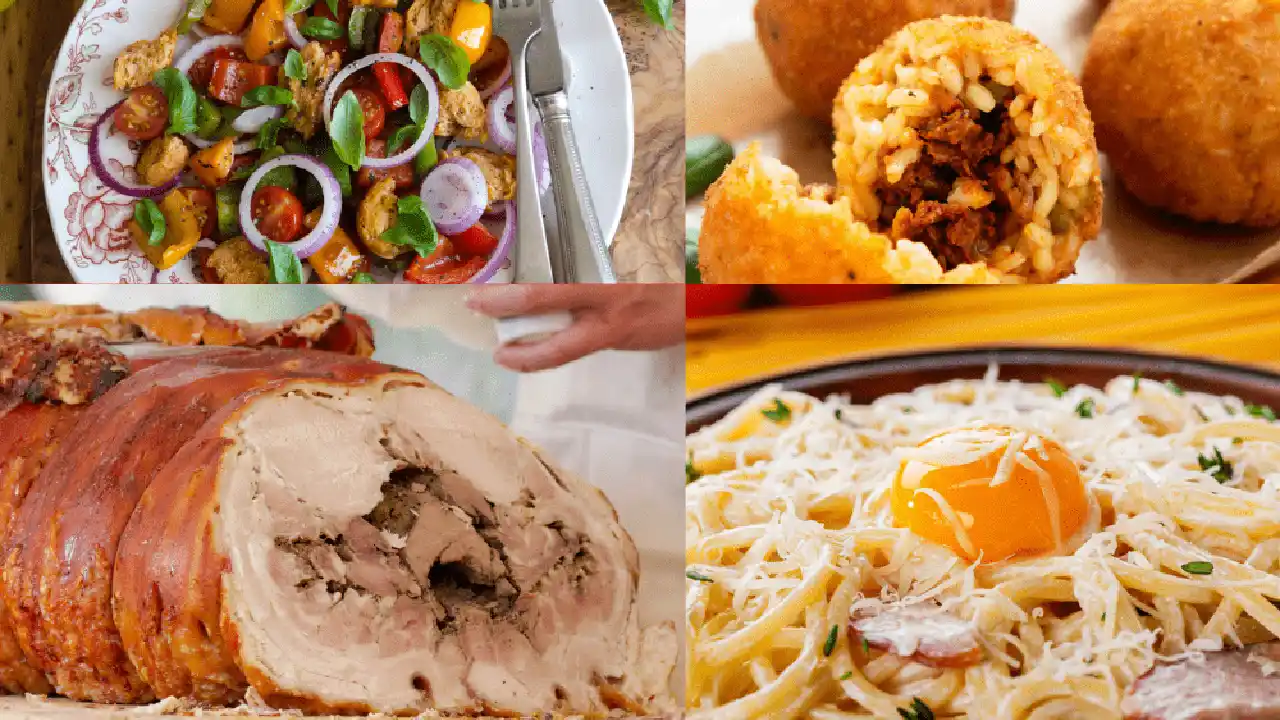7 Regional Italian Dishes You Must Try
Planning a trip to Italy? You absolutely HAVE to dive into the regional dishes. This guide showcases must-try specialties from Tuscany, Sicily, and beyond. Experience the authentic taste of Italy through its incredible food and regional culinary traditions.

Exploring Italian Regional Cuisine A Culinary Journey
Okay, let's be real. Italy isn't just pasta and pizza (though those are pretty darn great too!). Each region boasts its own unique culinary identity, shaped by local ingredients, history, and traditions. Forget the tourist traps and get ready to embark on a delicious adventure that goes way beyond the usual suspects.
Tuscany Food Adventures Bistecca alla Fiorentina
First up, we're heading to Tuscany for a real meat-lover's delight: Bistecca alla Fiorentina. This isn't just any steak; it's a thick-cut, bone-in T-bone steak grilled to perfection – crusty on the outside, rare on the inside. It comes from Chianina cattle, a breed native to Tuscany, known for its flavorful and tender meat. You'll typically find it seasoned simply with salt, pepper, and maybe a drizzle of olive oil. The key is the quality of the beef and the high heat of the grill. Pair it with a robust Tuscan red wine like Chianti Classico for the ultimate experience. Expect to pay around $50-$80 per kilo, depending on the restaurant.
Where to Try It: Trattoria Mario in Florence is a classic choice, known for its authentic Tuscan cuisine and no-frills atmosphere. Da Burde, also in Florence, is another fantastic option, especially if you want to try other regional specialties alongside your steak.
Sicily Food Delights Arancini Rice Balls
Next, let's hop over to Sicily for Arancini. These are fried rice balls, typically filled with ragu (meat sauce), mozzarella, and peas. They're coated in breadcrumbs and deep-fried until golden brown and crispy. Think of them as the ultimate Sicilian street food. There are many variations, including some filled with butter and ham (al burro) or spinach and ricotta (spinaci). They are perfect as a snack or a light meal. A single arancino will set you back only a few euros, making them a budget-friendly treat.
Where to Try It: Friggitoria Chiluzzo in Palermo is a legendary spot for arancini. They offer a wide variety of fillings and are always busy with locals. Another great option is Ke Palle Arancine in Catania, known for its innovative and gourmet arancini.
Emilia-Romagna Culinary Masterpieces Tortellini in Brodo
Moving north to Emilia-Romagna, the home of Parmesan cheese and prosciutto, we have Tortellini in Brodo. These small, ring-shaped pasta dumplings are traditionally filled with meat (usually pork, prosciutto, and Parmesan) and served in a clear, flavorful broth (brodo). It's a simple yet elegant dish, perfect for a cold day. The broth is key – it needs to be rich and savory to complement the delicate tortellini. A bowl will cost you about $15-$25.
Where to Try It: Trattoria Anna Maria in Bologna is a classic choice for tortellini in brodo. Another excellent option is Osteria Francescana in Modena (if you can get a reservation!), though you'll be paying a premium for the Michelin-starred experience.
Campania Food Experiences Pizza Napoletana The Original Pizza
We can't talk about Italian regional cuisine without mentioning Pizza Napoletana from Campania (Naples). This is the OG pizza, made with simple ingredients: San Marzano tomatoes, mozzarella cheese (preferably buffalo mozzarella), fresh basil, olive oil, and a perfectly charred crust. The dough is made with only four ingredients: flour, water, salt, and yeast, and it's traditionally cooked in a wood-fired oven at extremely high temperatures. The result is a soft, chewy crust with a slightly smoky flavor. A basic Margherita pizza will cost around $8-$12.
Where to Try It: L'Antica Pizzeria da Michele in Naples is arguably the most famous pizzeria in the world. Expect a long wait, but it's worth it. Another great option is Gino Sorbillo, also in Naples, known for its high-quality ingredients and innovative toppings (though sticking to the classic Margherita is always a good bet).
Lazio Food Sensations Cacio e Pepe Simple Perfection
Heading to Lazio (Rome), we have Cacio e Pepe. This is another incredibly simple dish, but don't let that fool you – it's all about technique. It's made with just three ingredients: pasta (usually spaghetti or tonnarelli), Pecorino Romano cheese, and black pepper. The key is to create a creamy sauce using the starchy pasta water and the grated cheese. It requires a bit of practice to get the consistency just right, but the result is a rich, flavorful, and satisfying dish. Expect to pay around $12-$18.
Where to Try It: Roma Sparita in Rome is famous for its Cacio e Pepe served in a crispy Parmesan basket. Another excellent option is Flavio al Velavevodetto, also in Rome, which offers a more traditional version of the dish.
Liguria Culinary Gems Pesto Genovese Aromatic Basil Sauce
Moving northwest to Liguria (Genoa), we have Pesto Genovese. This vibrant green sauce is made with fresh basil, pine nuts, garlic, Parmesan cheese, Pecorino cheese, olive oil, and a pinch of salt. It's traditionally made with a mortar and pestle, which helps to release the essential oils of the basil. Pesto is incredibly versatile – it can be used as a sauce for pasta, as a spread for sandwiches, or as a topping for grilled vegetables. It's usually served with trofie pasta or trenette pasta. A plate of pesto pasta will cost you roughly $15-$22.
Where to Try It: Trattoria Sa Pesta in Genoa is a historic restaurant known for its authentic Ligurian cuisine, including its delicious pesto. Another great option is Osteria Vico Palla, also in Genoa, which offers a more modern take on Ligurian classics.
Puglia Food Must-Haves Orecchiette alle Cime di Rapa Handcrafted Pasta
Finally, let's head to Puglia, the heel of Italy, for Orecchiette alle Cime di Rapa. Orecchiette means "little ears" in Italian, and this pasta shape is traditionally handmade in Puglia. It's served with cime di rapa, which are broccoli rabe (also known as rapini), garlic, chili flakes, and olive oil. It's a slightly bitter but incredibly flavorful dish. Some variations also include anchovies or sausage. This hearty pasta dish typically costs around $14-$20.
Where to Try It: Osteria Le Arpie in Lecce is a fantastic place to try Orecchiette alle Cime di Rapa. Another great option is Trattoria Terra Madre, also in Lecce, which focuses on using local and seasonal ingredients.
Essential Italian Food Products For Your Home Kitchen
Want to bring the taste of Italy home? Here are a few must-have products to stock your pantry:
- De Cecco Pasta: A high-quality dried pasta brand that cooks perfectly every time. Their spaghetti and penne are staples. Available on Amazon for around $3 per pound.
- San Marzano Tomatoes: These are considered the best tomatoes for making pasta sauce. Look for the DOP certification. Mutti brand is widely available and costs around $4 per can.
- Extra Virgin Olive Oil: Invest in a good quality extra virgin olive oil for drizzling, cooking, and dipping. Partanna is a great brand that offers a rich, fruity flavor. Expect to pay around $20-$30 per bottle.
- Pecorino Romano Cheese: This salty, sheep's milk cheese is essential for Cacio e Pepe and other Roman dishes. Locatelli is a well-known brand. Available at most specialty cheese shops for around $25-$35 per pound.
- Balsamic Vinegar of Modena: Aged balsamic vinegar adds a touch of sweetness and acidity to salads, grilled vegetables, and even desserts. Acetaia Leonardi is a high-quality brand with prices starting around $30.
Comparing Italian Food Products Budget vs Premium
It's tempting to go for the cheapest options when stocking your pantry, but sometimes it's worth investing in higher-quality ingredients. Here's a quick comparison:
- Pasta: Generic store-brand pasta will do in a pinch, but De Cecco or Garofalo pasta holds its shape better and has a better texture.
- Tomatoes: Regular canned tomatoes are fine for basic sauces, but San Marzano tomatoes have a sweeter, less acidic flavor that makes a big difference.
- Olive Oil: Cheap olive oil can be bland and even rancid. Good quality extra virgin olive oil has a distinct flavor and aroma.
- Cheese: Pre-grated Parmesan cheese lacks the flavor and texture of freshly grated Pecorino Romano or Parmesan Reggiano.
Ultimately, the best choice depends on your budget and your priorities. But even a few high-quality ingredients can elevate your Italian cooking to the next level.
:max_bytes(150000):strip_icc()/277019-baked-pork-chops-with-cream-of-mushroom-soup-DDMFS-beauty-4x3-BG-7505-5762b731cf30447d9cbbbbbf387beafa.jpg)






